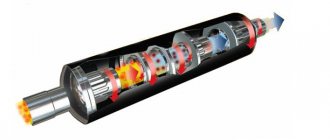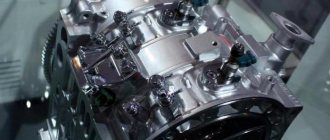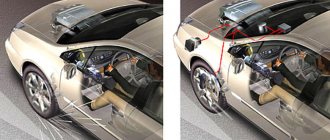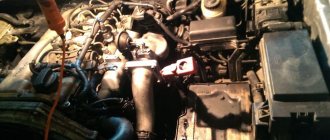Only an experienced car owner who has been using the vehicle for at least five years can evaluate the pros and cons of replacing a catalyst with a flame arrester. Optimizing the operation of the exhaust system while minimizing costs and adapting to the conditions of Russian reality is the main reason for re-equipping a vehicle.
- Kia Rio: flame arrester instead of catalyst. Video:
- How to correctly replace a catalyst with a flame arrester?
You can understand the advantages and disadvantages of the manipulations performed by finding out what the operating principle of both devices is.
Preparing materials
So, what do we need for work if we decide to make a flame arrester with our own hands? To do this, we need a product that will actively absorb sound. To save money, you can use the standard catalyst housing. In addition, it is already equipped with mounting flanges. All that remains is to modify it, eventually obtaining a flame arrester.
A stainless steel pipe must be inserted inside the element. The wall thickness should be about one to two millimeters. The diameter must correspond to the standard exhaust pipe. Please note that it is not always possible to install the catalyst in place after dismantling - it may turn out to be shorter (if the cut was made with a grinder). Therefore, we cut off 2 centimeters on each side for reserve. That is, our stainless steel pipe should be 4 centimeters longer than the neutralizer itself.
What to use as sound-absorbing padding? For this you can use:
- basalt fiber;
- bulk asbestos materials;
- high temperature wool;
- steel mesh made of thin wire.
Some people recommend using steel wool scourers as padding. However, as practice shows, such brushes quickly burn out because they are not designed for high temperatures. But the wire will do just fine. Are drawings needed? You can make a flame arrester with your own hands without any diagrams. The main thing is to have a tape measure with you to measure the exact length.
What to replace the cut out catalyst?
“I bought a 2002 Skoda Octavia 1.9 TDI with a cut out catalyst. I want to weld it back. I'm looking for something to put on. There is little information, but there are many advisers “why do you need it”. I would like information from competent sources: where to get it, whose production, how long it runs. Of course, they are interested in substitutes, since the “original” costs about 500 euros. Do not offer a flame arrester."
Where can I get an inexpensive replacement for the original exhaust gas catalytic converter or catalyst, as this unit is usually, but not technically correctly, called by motorists? Naturally, in the same place where substitutes for other automotive components are sold - in spare parts stores.
You need to search at retail outlets specializing in the sale of mufflers. The catalyst and muffler are parts of the exhaust system of a car, which explains their proximity on the shelves of companies that sell mufflers specifically.
The more solid the assortment of a retail outlet, the higher the likelihood that they will offer just what you need for the Skoda Octavia 1.9 TDI.
As our exhaust systems consultant Sergei Krivovyazov (Private Unitary Enterprise “Kripan”) reported, the problem of selecting a non-original catalyst for the Skoda Octavia 1.9 TDI, as well as for other Volkswagen models of the production years in question, equipped with the same engine, is that this unit, as well as the flame arrester designed specifically for the 1.9 TDI, has a special shape, dimensions and fastenings.
Since the flame arrester is rejected, we remove it from further consideration and leave only the catalyst. As you can see, there is no need to weld anything - the new unit comes with the corrugation and is simply placed in place of the old one.
The cost of such a catalyst in ruble terms is equivalent to 150 USD. The production is Polish, but some signs indicate that only the manufacture of some parts and the final assembly of the product seem to have taken place in Poland.
But it is difficult to say from whom the manufacturing company purchased the core. It is a corrugated metal tape rolled into a roll, on the surface of which a layer containing active substances is applied. These are the very catalysts in the presence of which toxic carbon monoxide, hydrocarbons and nitrogen oxides contained in exhaust gases are converted into harmless carbon dioxide, nitrogen and water.
It is again difficult to say how long such a catalyst will last, since the service life of these components, whether original or non-original, depends not only on the quality of workmanship. The main enemies of any catalyst are carbon deposits and soot, which clog the core over time. The intensity of their formation is influenced by operating conditions, as well as the technical condition of the engine. In particular, in urban conditions more carbon deposits and soot are formed than in suburban traffic. Even a serviceable engine, until it warms up, can smoke for some time, and if the adjustments are violated, the injectors spray fuel poorly because their nozzles are coked, due to wear on the valve stem seals and piston rings, the engine begins to intensively “eat up” the oil, it is thrown out of the cylinders into the exhaust tract, after which it enters the catalyst, where it lingers and turns into coke, then no one will undertake to predict when the catalyst will die for a long time. And that's not all that determines the service life of the unit.
What can be said definitely is that, unlike catalysts with a ceramic core, a catalyst with a metal filling is structurally protected from mechanical or thermal destruction.
Ceramics are indeed capable of crumbling under a strong impact on the catalyst body, which may occur when driving over an obstacle, or during sudden cooling caused, for example, by driving a car through a deep puddle.
In addition, universal catalysts can be found at retail outlets. Whether they will be offered to buy them in the absence of a catalyst designed specifically for the 1.9 TDI in the assortment is determined by the technical competence and conscientiousness of the sellers. Since the seller does not always have this or that in stock, and everyone wants to make money, we will not exclude the possibility that they may offer it.
A universal catalyst would be quite acceptable for purchase in cases where a standard catalyst is installed after the exhaust pipe, but this does not apply to the 1.9 TDI. You can, of course, try to weld in a “station wagon” to replace the one cut out by the previous owner, but, in our opinion, the game is not worth the candle. Firstly, a universal catalyst will cost 100-110 USD. Secondly, you will then have to use a welding machine and scraps of pipes of a suitable diameter to make something that will fit into place. So it is better to continue the search and find the catalyst considered initially, or people who will undertake to bring it to order. There is no need to run around the markets - serious companies that deal with exhaust systems have websites and online stores, so if you ask the right question in a search engine, you will most likely find the right answer, who to contact to purchase the product you are looking for.
Sergey BOYARSKIKH Photo by ABW.BY
You have questions? We have the answers. Topics that interest you will be expertly commented on by either specialists or our authors - you will see the results on the website abw.by. Send questions to [email protected] and follow the site
Let's get started
First we need to remove the catalyst from the car. To do this, we need to drive the car into the inspection hole. We also note that the exhaust system is subject to high temperature loads, so you should wait 10-20 minutes until the car cools down. After this, you can begin dismantling. As a rule, the catalyst is bolted between the exhaust pipe and the resonator. But it is also connected to the exhaust system. In the first case, we simply unscrew the nuts and take the element out. In the second, you will have to use a grinder. Please note that the nuts often stick in these places and can spin along with the bolt. Therefore, to unscrew the element, you need to use two keys - one to hold the bolt, and the other to remove the nut.
Sometimes the oxygen sensor is mounted directly into the converter. In this case, before dismantling, you should disconnect the connector with wires going to the sensor. At the next stage, we take our catalyst out. If you already have a ready-made flame arrester, all that remains is to attach it to its standard places or weld it into the system. It is advisable to make fasteners using new bolts, since old ones rust and can become deformed. Well, for those who decided to make a flame arrester with their own hands, at this stage the work is just beginning. We will tell you in detail about production below.
Automotive catalyst: purpose, principle of operation, types
The catalyst is located in the exhaust system and performs the function of removing and pre-purifying gases.
Inside the device, toxins are converted through chemical reactions into less harmful substances. This treatment results in minimizing environmental pollution.
The catalyst is activated as a result of heating, so it does not function when the engine is cold started. It operates in close symbiosis with oxygen detectors.
Thanks to them, the optimal ratio of the composition of the mixture consisting of gasoline and air is formed, which, depending on this, becomes leaner and enriched.
The detectors, guided by the available readings, control the catalyst located between the muffler and the engine.
It is provided to be covered with a special screen, since as a result of strong heating it becomes very hot. The unit can be in several states:
1. Working. Characterized by the normal condition of the car. The error light does not light up when the engine starts.
2. Half working. Traction periodically disappears, the engine becomes less responsive at high speeds.
The car starts worse when started hot and it becomes necessary to repeatedly drive the starter.
When you press the gas pedal, the tachometer needle cannot overcome the 4 mark, and fuel consumption increases.
3. Non-working. It is in such a situation that the catalyst must be replaced, since the vehicle begins to stall immediately after starting the engine or does not start at all.
Attention! You can identify a non-working condition by placing your hand in the pipe when the vehicle is started, checking the release of gases; if this does not happen, then the system does not function.
There are several types of neutralizers:
- tripartite;
- for lean fuel mixtures;
- bilateral;
- for diesel engines.
Double-sided models can neutralize unburned gasoline and carbon monoxide. Three-way modifications additionally break down nitric oxide, releasing oxygen from it. Diesel analogues prevent soot emissions.
We remove the catalyst and install a flame arrester. Video:
How to make a flame arrester with your own hands?
To convert a standard catalyst into a flame arrester, you need to perform the following work:
- Cut the metal case into two parts. It is better to make a cut along the factory seam or directly along it.
- Halve the body and knock out all the contents from the neutralizer. This will be a ceramic core, which is a set of numerous honeycombs. You can knock out the contents with a regular hammer and chisel.
- Use the stainless steel pipe prepared earlier. It is important that it fits flush inside the housing. If necessary, the excess part should be trimmed with a grinder.
- Place the pipe in a vice and use a core to mark the locations for future holes. Using a drill with a diameter of 8 millimeters, we make holes. Drill speed should be minimal. Stainless steel is a very strong metal, so the drill can quickly overheat and become dull. It is important to periodically lubricate the work surface with some kind of oil.
- Remove all burrs from the perforated pipe. If this is not done, the part may remain inside and then make a loud noise when the engine is running.
- Install a stainless steel pipe with pre-drilled holes into the catalyst housing. Install basalt wool or other non-flammable packing between the walls of the neutralizer and the pipe. Scald the body halves on both sides.
The main reasons for replacing the catalyst with blende and the advantages of a flame arrester
Is there any logic in using this device if you can just install a new filter? However, when a car owner finds out how much a new catalyst costs, he involuntarily thinks about a flame arrester. The cost of a catalyst on the market varies from 30 to 100 thousand rubles. Even if this component is purchased for domestically produced cars, the prices are exorbitant.
So we get to the main reason why car enthusiasts choose a resonator - low cost and easier repairs. If a car costs 400 thousand rubles, and the cost of a catalyst is 70 thousand rubles, then such costs make you think a lot.
The shelf life of blende is 3-5 years. The catalyst is changed every 100 thousand kilometers. The collector version of the flame arrester works for up to 6 years, and the main alternative “lives” for up to 10 years.
Advantages of a flame arrester:
- You can use 92 gasoline.
- By removing the expensive filter, you are able to use lower octane fuel.
- This will reduce your costs.
- Increased engine power.
- The catalyst reduces engine power by 7% as it reduces the flow of exhaust gases.
- After installing the blende, the gases encounter virtually no resistance.
It is also worth noting that installing a flame arrester does not cause engine damage. If we think logically, then inside the exhaust system the obstacle to the exit of exhaust gases was simply removed. Could this have a negative effect on the engine? Hardly…
note
The seam should be as tight as possible. Otherwise, gases will break out, which will affect the efficiency of the system and the exhaust sound itself.
The installation of this design is no different from the installation of a standard catalyst or a ready-made flame arrester. You can weld such an element with your own hands and also install it on standard fasteners.
Regarding the number of holes, there are no specific requirements. But it is worth using the rule that the more holes, the more effective the sound absorption. Of course, making a sieve is time-consuming and makes no sense. The best option is an interval between holes of five centimeters.
What does the price consist of:
The cost of a high-quality flame arrester.
The cost of a really working decoy, and not an empty screwdriver that doesn’t work.
Cost of other consumables.
Your car will be handled by qualified specialists (locksmiths, diagnosticians). The welding quality is perfect. There will be no exhaust smell in the cabin due to unwelded seams.
People turn to any car service center with a request to remove the catalyst - and the specialists there willingly take on this work, without experience and without warning the client about the possible consequences. It ends with the catalyst errors (Check), and the sound of the foreign car’s exhaust becomes unpleasant, ringing, similar to the sound of the exhaust of a Volga or Gazelle. The cabin smells like exhaust. Half of our clients come from such multidisciplinary car services. Clients pay twice.
We do our job right the first time and always! Saving can cost you time, nerves, and vehicle downtime!
Our car service offers the most optimal compromise in Chelyabinsk:
PRICE-QUALITY-PERFORMANCE TIME
How does the catalyst work?
Inside the catalyst body there is either a ceramic or metal honeycomb structure on which a thin layer of a special metal alloy is applied. The honeycomb structure in the catalyst is necessary to increase the contact area of the exhaust gases with the surface on which the catalytic layer is applied. As a result, a chemical reaction occurs that oxidizes CO and CH, which are harmful to the environment, and the output is completely harmless CO2 and N2.
We removed the catalyst and replaced it with a flame arrester on : Audi A6, Q5, Q7; Mercedes E-class W211, W212, ML, GLK, Sprinter; BMW 320d, 530d, X3, X5, X6; Opel Astra, Antara, Zafira; Volkswagen Amarok, Passat, Touareg, Tiguan, T5, Multivan, Caravelle, Crafter; Volvo XC60, XC90; Nissan X-Trail, Pathfinder, Navara; Toyota Land Cruiser 200, Prado; Lexus ; Mitsubishi Pajero, L200; Mazda CX7, Hyundai Santa-Fe; Kia Sorento, Ceed; Ssangyong Actyon, Kyron, Rexton; Ford Mondeo, Focus, S-max, Kuga, Transit; Infiniti 30d, Land Rover Discovery, Freelander, Range Rover Sport, Vogue; Skoda ; Chevrolet Captiva, Citroen ; Peugeot ; Fiat Ducatto; Jeep Grand Cherokee, Liberty, Patriot, Commander, Compass; Renault Megane, Duster; Isuzu ; MAN ; Iveco Daily, Eurocargo. And many other cars...
About the oxygen sensor
Regardless of how you replaced the catalyst with a flame arrester yourself, in any case you need to get rid of the oxygen sensor. It is because of this that disturbances in engine operation can then occur. First of all, “Check” will light up on the panel. What if we installed a flame arrester instead of a catalyst with our own hands? There are several options to solve this problem:
- installation of metal blende;
- re-flashing of the electronic control unit to the Euro-2 standard.
We also note that on older cars the lambda probe does not take into account the change in the oxygen content in the gases. Therefore, such machines do not need any firmware or deception. Such vehicles can be recognized by the location of the sensor installation. The latter will be located in the exhaust pipe or exhaust manifold. Well, if the lambda probe is mounted in the catalyst housing or there are two of them, then you will have to install a snag or do firmware. As noted in the reviews, the most budget-friendly option is the first option. You can buy such a decoy for 300-400 rubles, and there will be no problems installing it. The part is mounted in the standard places of the exhaust pipe.
Price for removing particulate filter
A particulate filter is installed to clean the exhaust gas from small impurities and soot particles. This part often gets clogged and fails during active use of the car.
The AvtoVykhlop workshop removes particulate filters in Kirov at a price that depends on the make of the car, the ECU, the series of software installed on the car, the complexity of the work operations, etc. We carry out professional and prompt removal of particulate filters , which often become clogged when using low-quality fuel.
When ordering additional services for welding supply pipes and corrugations, the repair price will be determined taking them into account. Otherwise, the price for replacing a catalytic filter is fixed. The final cost of the work will depend only on the model you choose. Hurry up to make an appointment for diagnostics and repair of the catalyst today!











